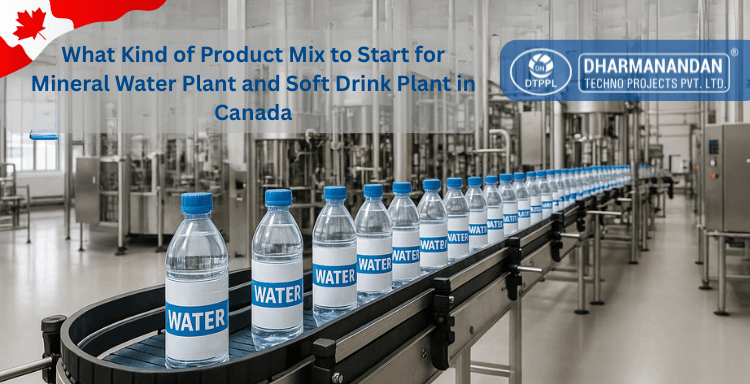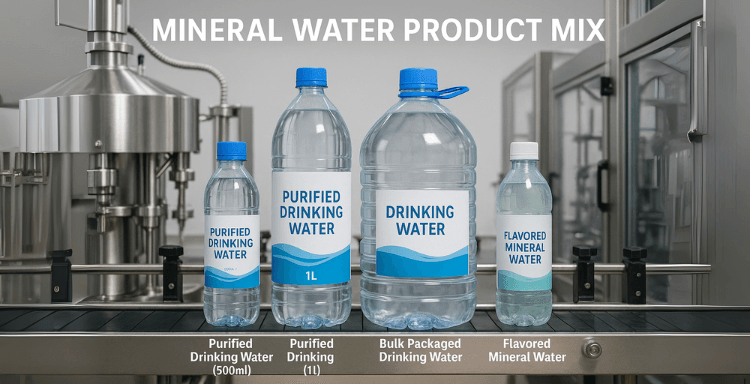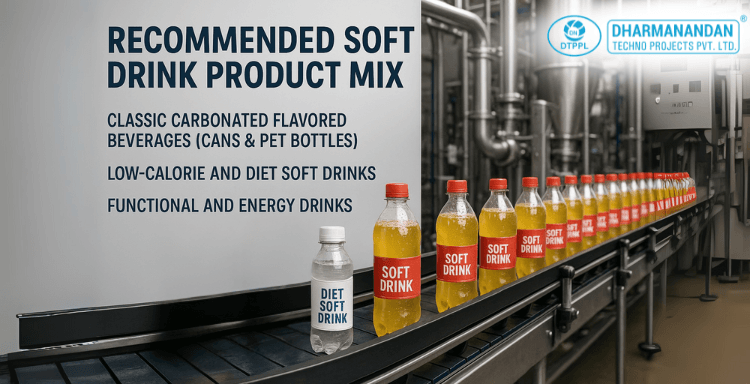
Table of Contents
What Kind of Product Mix to Start for Mineral Water Plant and Soft Drink Plant in Canada?
June 26, 2025
From Ontario to British Columbia and Alberta, the preference for healthy, safe and flavorful drinks continues to rise. Yet, selecting the appropriate product mix is a critical decision that influences machinery investment, production design, packaging formats and long-term profitability.
This article offers detailed guide for exploring beverage production in Canada. It outlines the best product combinations to launch based on local market demand, technical feasibility and infrastructure considerations – helping manufacturers determine how to align their mineral water factory units for optimal output and market reach.
Understanding Market Dynamics in Canada
Canada’s beverage market is characterized by its diversity in consumer preferences. The demand ranges from purified bottled water for health-conscious individuals to carbonated beverages enjoyed across age groups and social settings. Regional climate, cultural preferences and retail infrastructure play key roles in shaping what products will perform best.
In cities like Toronto, Vancouver, Calgary and Montreal, convenience-driven lifestyles support strong sales of single-serve bottled water and flavored sodas. Institutions such as schools, offices and hospitals tend to purchase large-format dispensers and multi-pack soft drinks. This sets the stage for a carefully designed product mix that addresses multiple end-user segments with varied packaging and formulation strategies.

Recommended Mineral Water Product Mix
A Mineral Water Plant in Canada should consider offering a range of water products tailored to both retail and institutional needs. Below are key product lines that may be included in the initial mix.
1. Purified Drinking Water (500ml & 1L)
This product is treated through advanced filtration and UV or ozone disinfection. It appeals to the general public and retail customers. These lines are supported by automatic mineral water filling machines, which ensure consistent volume control and hygienic sealing.
2. Bulk Packaged Drinking Water
Ideal for offices, commercial spaces and public events. These require larger-capacity filling units and can be integrated into a soft drink production line infrastructure where filling, capping and labeling modules can be adapted.
3. Flavored Mineral Water
This is an emerging category that merges the benefits of hydration with light natural flavors. Using separate dosing tanks and quality checks, these products may share lines with soft drinks plant units if flavor integrity is carefully maintained.
The mineral water plant project cost may vary depending on the degree of automation and the variety of packaging lines. Operators should assess cost-effectiveness in relation to their launch volume and distribution capacity.

Recommended Soft Drink Product Mix
Canada has a mature market for beverages, but consumers are increasingly exploring alternatives that offer more than just sweetness and fizz. The ideal Soft Drink Plant in Canada may consider launching with these core products:
1. Classic Carbonated Flavored Beverages (Cans & PET Bottles)
Cola orange and lemon-lime remain highly popular. These beverages require dedicated carbonation systems integrated with beverage filling machines that manage pressure-sensitive bottling. Cooling and carbonation modules are critical to maintaining beverage quality.
2. Low-Calorie and Diet Soft Drinks
Given the shift toward health-conscious options, low-sugar or zero-calorie variants with natural sweeteners may be included. These require careful ingredient dosing, for which a batch-controlled soft drink production line is recommended.
3. Functional and Energy Drinks
This includes caffeine-based beverages, vitamin-enriched sodas or electrolyte drinks, often sold in 250ml or 330ml formats. Facilities may need separate syrup tanks and sterilization systems to maintain safety and ingredient stability.
These products should be sealed and labeled with precision. Advanced machinery for sealing and labeling not only improves shelf appeal but also ensures compliance with Canadian labeling standards.
Combining Mineral Water and Soft Drinks in a Shared Facility
Running a dual production setup is feasible and may enhance operational efficiency. Shared
infrastructure includes:
- Bottle rinsing and drying units
- Labeling systems
- Shrink wrapping and packaging modules
However, manufacturers must maintain separate water storage, blending and filling lines to avoid cross-contamination. For example, flavored beverages processed through the beverages production line should not share tanks with mineral water products.
Smart investments in flexible equipment – like multi-head soft drinks filling machines and adaptable bottling conveyors – help streamline production while supporting a wider product portfolio.
Packaging Formats That Complement the Product Mix
An effective packaging strategy enhances product visibility and simplifies logistics. Canadian consumers are familiar with a wide range of container types:
- Medium PET Bottles: Family-size, commonly sold in grocery outlets.
- Cans (250ml to 355ml): Standard for carbonated drinks, energy drinks.
- Large Bottles or Jars: Preferred by offices and large families.
A flexible filling and capping unit supports quick transitions between formats and reduces production downtime. The mineral water machine price will reflect this flexibility, so equipment planning should align with projected demand volumes.
Technical Factors Affecting Product Mix Planning
To execute a successful product strategy, manufacturers must address the following technical areas:
- Water Source and Purity: A new mineral water plant must secure access to clean, consistent water. Treatment systems should meet federal safety regulations.
- Carbonation and Ingredient Control: Soft drink lines must manage CO₂ levels, sugar content and pH for optimal flavor.
- Labeling and Regulatory Compliance: Canada requires bilingual labels, ingredient transparency and nutritional declarations. Packaging lines must support these requirements through automated inspection and labeling systems.
- Equipment Maintenance and Adaptability: Choosing machinery with modular design supports scaling up as product lines expand.
Conclusion
Choosing DTPPL’s right product mix for a mineral water plant and soft drink plant in Canada involves a blend of market analysis, technical capability and regulatory foresight. By launching with a focused combination – such as purified bottled water, classic sodas and a select flavored variant – producers can establish brand presence and build operational experience.
With high-efficiency mineral water filling machines and modern soft drinks production lines, facilities can maintain high output standards and explore future product extensions with minimal reconfiguration. A flexible, well-planned product mix not only meets current demand but also positions the facility for growth in a dynamic beverage market.
About Author

Director – Global Marketing and Sales
Mr. Bhavesh from Dharmanandan Techno Projects Pvt. Ltd. has played a pivotal role in elevating the DTPPL brand to the global stage, leveraging his exceptional expertise in marketing and communications. He is committed to helping clients achieve significant growth while strengthening their own brands. Dharmanandan Techno Projects Pvt. Ltd. is a leading manufacturer and supplier of water purification systems and turnkey solutions for mineral water plants. With years of experience in designing and delivering high-quality water treatment solutions, the company provides end-to-end services, including system design, installation, maintenance, and ongoing support. Specializing in scalable and customizable water plants, DTPPL has successfully served industries worldwide, ensuring clean and safe drinking water across diverse applications.




